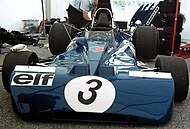The Tyrrell Racing Organisation was an auto racing team and Formula One constructor founded by Ken Tyrrell (1924–2001) which started racing in 1958 and started building its own cars in 1970. The team experienced its greatest success in the early 1970s, when it won three Drivers' Championships and one Constructors' Championship with Jackie Stewart. The team never reached such heights again, although it continued to win races through the 1970s and into the early 1980s, taking the final win for the Ford Cosworth DFV engine at the 1983 Detroit Grand Prix. The team was bought by British American Tobacco in 1997 and completed its final season as Tyrrell in the 1998 Formula One season. Tyrrell's legacy continues in Formula One as the Mercedes-AMG F1 team, who is Tyrrell's descendant through various sales and rebrandings via BAR, Honda, and Brawn GP.

Albert François Cevert was a French racing driver, who competed in Formula One from 1969 to 1973. Cevert won the 1971 United States Grand Prix with Tyrrell.
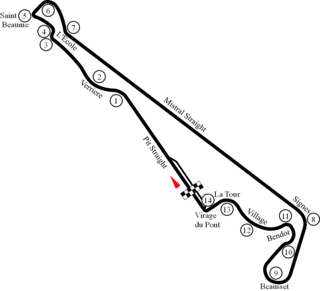
The 1971 French Grand Prix was a Formula One motor race held at the Circuit Paul Ricard on 4 July 1971. It was race 5 of 11 in both the 1971 World Championship of Drivers and the 1971 International Cup for Formula One Manufacturers. The 55-lap race was won by Tyrrell driver Jackie Stewart after he started from pole position. His teammate François Cevert finished second and Lotus driver Emerson Fittipaldi came in third.

The 1972 South African Grand Prix, formally the Sixth AA Grand Prix of South Africa, was a Formula One motor race held at Kyalami on 4 March 1972. It was race 2 of 12 in both the 1972 World Championship of Drivers and the 1972 International Cup for Formula One Manufacturers. The 79-lap race was won by McLaren driver Denny Hulme after he started from fifth position. Emerson Fittipaldi finished second for the Lotus team and McLaren driver Peter Revson came in third.

The 1973 United States Grand Prix was a Formula One motor race held on October 7, 1973 at the Watkins Glen Grand Prix Race Course in Watkins Glen, New York. It was race 15 of 15 in both the 1973 World Championship of Drivers and the 1973 International Cup for Formula One Manufacturers.
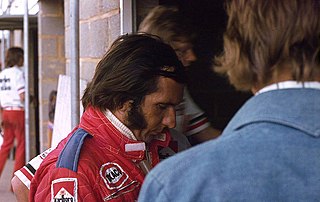
The 1974 Formula One season was the 28th season of FIA Formula One motor racing. It featured the 1974 World Championship of F1 Drivers and the 1974 International Cup for F1 Manufacturers, contested concurrently over a fifteen-race series which commenced on 13 January and ended on 6 October. The season also included three non-championship races.
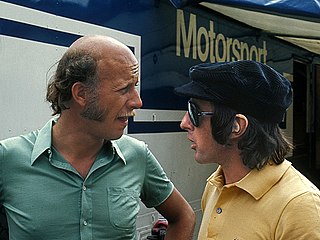
The 1973 Formula One season was the 27th season of FIA Formula One motor racing. It featured the 1973 World Championship of Drivers and the 1973 International Cup for F1 Manufacturers, which were contested concurrently over a fifteen-race series that commenced on 28 January and ended on 7 October. The season also included two non-championship races which were open to both Formula One and Formula 5000 cars.

The 1972 Formula One season was the 26th season of the FIA's Formula One motor racing. It featured the 23rd World Championship of Drivers, the 15th International Cup for F1 Manufacturers, and numerous non-championship Formula One races. The World Championship season commenced on 23 January and ended on 8 October after twelve races.

The 1971 Formula One season was the 25th season of the Fédération Internationale de l'Automobile's Formula One motor racing. It featured the 22nd World Championship of Drivers, the 14th International Cup for F1 Manufacturers and a number of non-championship races open to Formula One cars. The World Championship was contested over eleven races between 6 March and 3 October.
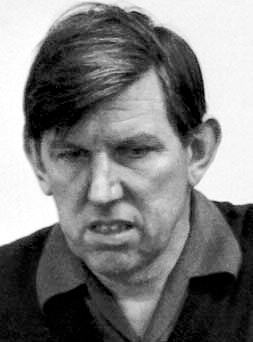
Robert Kenneth Tyrrell was a British Formula Two racing driver and the founder of the Tyrrell Formula One constructor.

The McLaren M23 was a Formula One racing car designed by Gordon Coppuck, with input from John Barnard, and built by the McLaren team. It was a development of the McLaren M16 Indianapolis 500 car. A Ford Cosworth DFV engine was used, which was prepared by specialist tuning company Nicholson-McLaren Engines. This helped push the DFV's horsepower output to around 490 bhp.

The Tyrrell 006 was a Formula One car designed and built by the Tyrrell Racing Organisation. It was introduced towards the end of 1972. In the hands of Jackie Stewart it won the Drivers' Championship for the 1973 Formula One season, Stewart's third and final title. The car was first raced at the 1972 Canadian Grand Prix with Stewart's teammate and protégé François Cevert at the wheel. The 006 was a very slightly reworked version of the preceding Tyrrell 005 car, but in contrast it was the first Tyrrell-built models to be replicated, the number 006 becoming a model- rather than chassis-number; previous Tyrrells were one-off constructions. In total there were three Tyrrell 006 chassis built: 006; 006/2; and 006/3. The 006 model was gradually phased out in the early part of the 1974 Formula One season as Tyrrell constructed the succeeding Tyrrell 007.

The Ferrari 312B is a Formula One racing car designed and built by Scuderia Ferrari. It was the successor to the Ferrari 312 and was used from 1970 until early 1975. The original 312B was developed into the 312B2 and 312B3.
Derek Gardner was a car designer known for designing advanced transmission systems. He was born in Warwick, and joined Formula One while employed by Harry Ferguson Research, developing four-wheel drive systems for Matra in 1969. He met Ken Tyrrell in 1970 and Tyrrell chose Gardner to design his chassis. The first chassis, the Tyrrell 001, was built in his garage at home and was raced in the 1970 Canadian Grand Prix.

The March 701 is a Formula One racing car model, designed by Robin Herd with Peter Wright, and built by March Engineering. The 701 was March's first Formula One design – following their one-off March 693P Formula Three prototype of 1969 – and was designed and built in only three months. The March 701 made its race debut a month after its public unveiling, at the 1970 South African Grand Prix. In total, eleven 701s were constructed, with March supplying many privateer entrants as well as their own works team. The 701's career started well, March drivers taking three wins and three pole positions from the car's first four race entries, but lack of development through the 1970 Formula One season resulted in increasingly poor results as the year wore on. The 701 was superseded by the March 711 in 1971, and made its last World Championship race appearance at the 1971 Italian Grand Prix.

The Tyrrell 002 is a Formula One racing car which was designed for the 1971 and 1972 Formula One seasons by Tyrrell's Chief Designer, Derek Gardner. It was essentially the same design as the Tyrrell 001, but incorporated some detail changes, and 002 were built with longer monocoques, as François Cevert was taller than Jackie Stewart.

The Tyrrell 001 is a Formula One racing car which was designed by Tyrrell Racing's chief designer, Derek Gardner and used at the end of the 1970 and the beginning of the 1971 Formula One season. The car competed in five Grands Prix, retiring on four occasions and achieving one second-place finish.

The Tyrrell 004 is a Formula One racing car which was designed for the 1972 Formula One season by Tyrrell's Chief Designer, Derek Gardner. It is the fourth and final car built of the basic Tyrrell 001 design. The 004 was seen in five races, three with Tyrrell: Jackie Stewart drove the 004 in the Monaco Grand Prix to finish 4th; the Scotsman was also scheduled to drive it in the Belgian Grand Prix, but a stomach ulcer put him out of the race, and the team did not use a replacement driver. Patrick Depailler drove the 004 in the French Grand Prix and was not classified, and the Frenchman was given one more opportunity in the 004 for the United States Grand Prix and finished 7th.

The Tyrrell 005 is a Formula One racing car that was designed for the Tyrrell team by their Chief Designer, Derek Gardner. Jackie Stewart drove the 005 in the final four races of the 1972 Formula One season, and it was also used for selected races of the 1973 and the early part of the 1974 seasons. Only one chassis was built and Gardner designed it with a particularly short wheelbase of 94.05 in (238.9 cm) specifically to suit Stewart's style and abilities.

The Tyrrell 007 is a Formula One racing car, designed by Tyrrell's Chief Designer, Derek Gardner. It was used in the 1974, 1975, 1976 and 1977 Formula One seasons.



